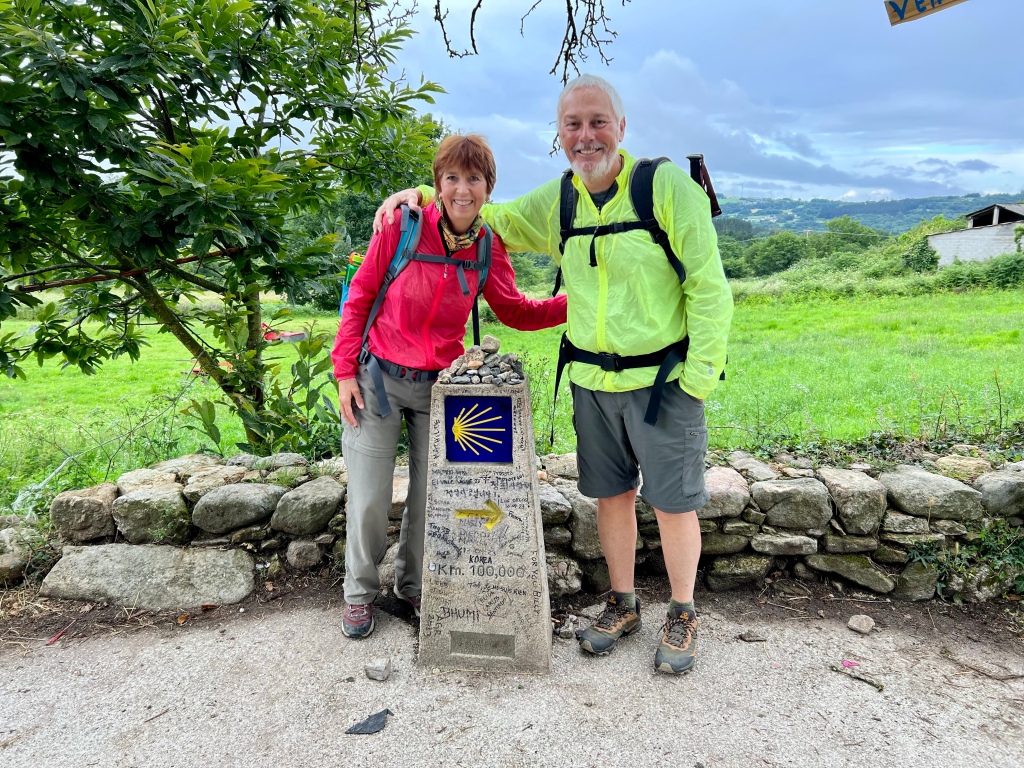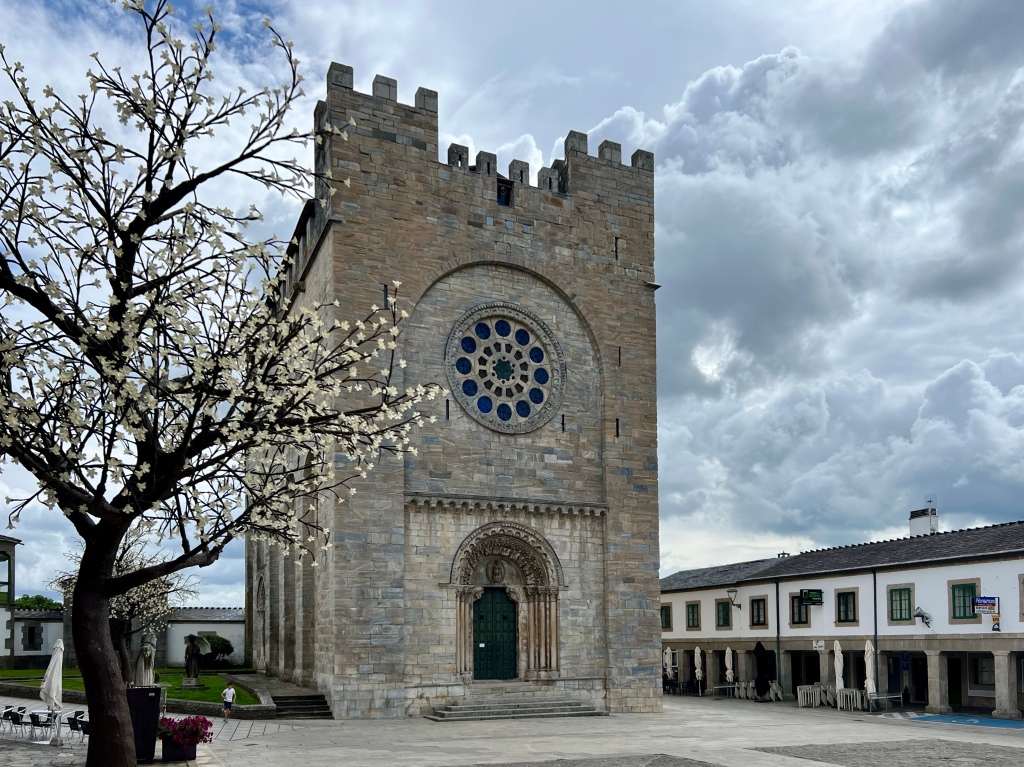- Distance – 10.44km (703.62km total)
- Walking time – 2 hours 30 minutes
Our included breakfast was better than expected – juice, toast with tomatoes and coffee. Although the coffee was from an urn it was good and we had a second cup talking to some Americans who had started from Sarria. It was a very easy (and short) walk to Portomarín through beautiful countryside.

We passed the iconic signpost that shows that we only have 100km left until Santiago.

Portomarín is a modern town, dating mostly from the middle of the 20th century.

In the 1950s, Franco decided he wanted to build a hydro-electric dam 40 kilometres down-river. When the Embalse de Belesar Dam was completed in 1962, the valley was flooded and the original town was submerged below the River Miño. However during the construction period, major monuments (including the churches of San Nicolás and San Pedro) were moved block by numbered block to their new location in the centre of town.

We arrived before noon and therefore our room at Casa do Maestro wasn’t ready. We dropped our rucksacks and explored the pretty town. We enjoyed a vermouth at Perigrinatio Art Bar before visiting the church of San Nicolás. The church was built in the 12th/13th centuries and was designed to be both a church and a fortress, with architectural characteristics of both. It controlled the bridge that crossed the River Miño and looked after the pilgrims’ hospital in Portomarín.

After visiting the church we were able to check in and have a shower before a late lunch (a good menu del día at Pousada do Camiño). We had an upgraded room with a balcony so we spent the rest of the afternoon watching the arriving pilgrims; Ken managed a sleep (probably the effects of vermouth and wine!). We attended Mass in the church of San Nicolás and returned to our balcony to watch the world go by. Another excellent day on the Camino and now we only have four days until we reach Santiago. Our amazing adventure is rapidly coming to an end.

The end is coming up fast what plans do you have next? Also a couple of travel questions I would like to pose to you. Are you using a iPad or small notepad to write your blog? I carried a mini iPad on our last Camino and used “Find Penguin” as a travel diary I won’t be using it again as the support from Germany was very add hoc. I think I might try “Polar Steps” not sure if you have herd anything about these travel diaries? Next question did you use a locale SIM on your phone? Sandra used a Spanish Vodafone sim (I tethered my iPad to it) and bought what she thought was a two month plan. The plan turned out to be only one month which was very annoying as it meant a new mobile number and consequently problems with banking using two-step-verification. Which leads onto my final question how did you get around two-step-verification when dealing with banking matters while overseas? In the event you have to top up a travel card or move money around in accounts etc.. Sorry for the barrage of questions but I know you guys are well seasoned travellers. You gave me great advice on my boots and I am very grateful.
LikeLike
Hi both,
To answer your questions:
– on Friday we fly to Munich to spend 11 nights with our friends before returning to South Africa. In July we have a cruise along the Norwegian coast and Svalbard to look forward to, Heathrow strikes permitting!
– we both have iPhones (no iPad or laptop) which we use for taking photos (Ken’s is a 13 pro) and for writing the blog.
– we use WordPress for our blog (which we set up in 2017) and is easy to use on a phone.
– we don’t have a local SIM. Wifi is widely available so we can use WhatsApp to communicate with local restaurants, accommodation to make bookings.
– we have set up roaming for our South African phone numbers (and obviously have kept the SIM cards in our phones) so we can receive messages for two-step verification. When we are not waiting for a message, we keep the phones on Airplane mode to avoid roaming charges.
– we use Revolut (which is a prepaid debit card) but also make sure that we have a couple of other cards with us. However ApplePay is widely available, so we seldom touch the physical cards. Even the ATMs in Spain allow you to tap rather than insert a card.
Hope that helps, but if you’ve any more questions, please let us know.
LikeLike
Great that is so very helpful. Wow you have great schedule coming up. The idea of using our phone to keep our Australian SIM might be the way to go next time? The only draw back is we used mobile data to navigate with on our last Camino. The Norte was very tricky in places with no clear signs in some locations and so we used a mapping app called Camino Del Norte which was very useful for navigating. The only problem was we needed data to run the app. On one stretch it showed a short cut on the app (long cut) as went through a storm water tunnel 150m long under a highway. We came out the other end into very dense bush but thankfully we had reception and managed to navigate using the phone. We did use WhatsApp for booking it was great. Booking online was a pain with no ability to receive 2-step- verification but luckily most places took Paypal our last option when booking online ahead. Thanks again for the advice.
LikeLike
You’re very welcome. As you know, the Camino Francés is very well marked and almost impossible to get lost on. We downloaded Google Maps and Maps ME for offline viewing and that was enough for us to find our accommodation at the end of a stage.
LikeLike